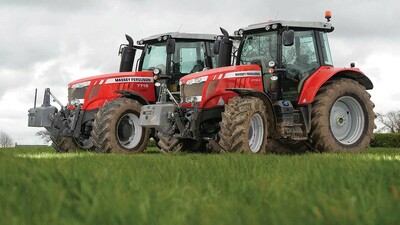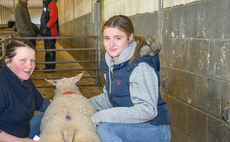To see if the latest high-powered four-cylinder tractors can compete with their six-cylinder counterparts, we pitted equivalent powered MF tractors against each other. James Rickard and Richard Bradley report. Pictures by Marcello Garbagnoli.
Main Pic
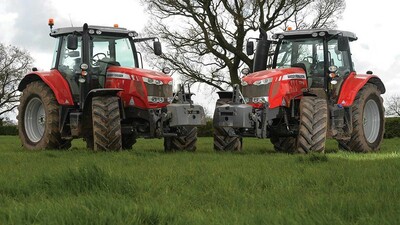
Aside from front axle and abundance of the six-cylinder's throaty tones, it is difficult to tell the difference between the 6718S and 7718.
Intro 1
Ever since diesel power took over from steam, there has been a long debate as to whether a four-cylinder tractor could ever match up to an equivalent-powered six-cylinder.
It is an argument which is more prevalent than ever, as manufacturers continue to push the power envelope with smaller engines.
One manufacturer which is pushing the limits of four-cylinder output is Massey Ferguson, with the recent launch of its 6718 S model, a 200hp four-cylinder tractor. To compare its performance, we put it up against its equivalent six-cylinder stablemate, a MF 7718.
Intro 2
Apart from engine and front axle, the specification of both tractors is identical. In addition, to help with traction and balance for all tasks, each tractor was equipped with an 850kg front weight block.
To find out what the real differences are between the two tractors in real-life situations, we carried out various tasks, which took into account fuel use, engine characteristics, stability, manoeuvrability and traction.
For simplicity, throughout the test we shall refer to the four-cylinder as the 67 and the six-cylinder as the 77.
head to head pic
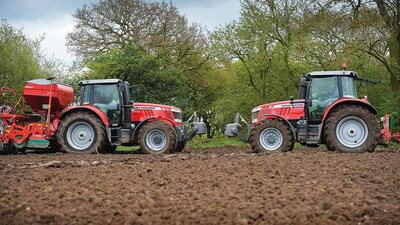
Both machines swapped between heavy draft on the plough, and worked the combi-drill for some more agile duties.
Tractor specifications as tested:

Dynometer test results:
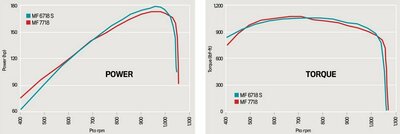
To get an idea of the engine performance of each tractor, both were subject to a dynometer test.
Before even getting to the field, the dyno results showed there is very little difference in engine performance, both in terms of power and torque.
Over the weighbridge:

Weighed with and without the plough, the aim here was to see just how much of a weight difference there is between the two tractors, particularly around the front axle.
Both tractors were weighed with full tanks of fuel and 850kg front weight blocks. The plough weighs 1,900kg.
Fuel use:
Fuel use was measured using a metered pump for total fuel used during muck spreading duties and fuel observations were made, via the tractor's own telemetry, for ploughing and drilling activities.
Fuel use chart

On the muck spreader
Spreaders body
- The test: Equipped with a pair of 13.2cu.metre Bunning Lowlander Mk 4 rear discharge muck spreaders, the aim of this task was to test how the tractors would cope with a mix of high-powered pto work, and the transition from field to road.
Working together, each tractor completed 30 loads from farm to field, with a 1.5-mile round trip following a twisty farm track.
Tyre pressures were set at 20psi to handle the weight of the spreader and to be able to cope with high transport speeds, but still forgiving enough to provide decent traction in the field.
- Engine characteristics: On the spreaders, both tractors offered very similar power and torque levels right through the rev range, enabling both the 67 and 77 to meet the power and forward speed demands of the spreaders. As you can see in the fuel use table, there was hardly anything between them.
However, the four-cylinder is a little more responsive to throttle input, but the biggest difference comes from engine noise; the six is a lot smoother and sounds sweet right through the rev range, while the four has more of a metallic rattle when it gets to high revs above 1,650rpm.
- Stability: In-field there was little difference, but with loaded spreaders travelling on a relatively rough farm track, the longer wheelbase 77 was much more composed, while the 67 had a tendency to act like a bucking bronco.
- Manoeuvrability: While not really an issue in the field on this task, the difference in tractor lengths was noticeable when turning in and out of gateways onto narrow tracks, and the 77 certainly had more of a presence in the yard. In comparison, the 67 was much more nimble.
- Visibility: Naturally, the shorter bonneted 67 has the edge on forward visibility, particularly to the front weight. This makes it a lot easier to navigate the four-potter through twisty farm tracks and tight gateways.
- Conclusion: For muck spreading duties, we would be happy to use either tractor. The main deciding factor will be what physical space you have available, such as farm tracks, gateways and yard.
77 spreading
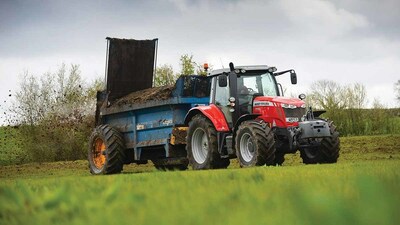
On the plough
Plough body
- The test: Using a Kverneland ED85 five-furrow reversible plough, the aim of this task was to show the differences in low down engine power, traction, balance and agility.
Ploughing at a depth of 250mm and a furrow width of 350mm, soil types ranged from medium loams to heavy and sticky clays. For traction, tyre pressures were reduced from 20psi to 15psi.
- Engine characteristics: Working at speeds of 6.5kph (4mph) with 1,500rpm for the vast amount of time, little could be placed between the grunt of the 67 and 77. While we could have easily lowered engine revs in either machine, it meant slower recovery from the engine, again only slightly more prominent in the 67.
- Stability: Despite its 850kg nose weight, the 67's reduced number of cylinders and lighter duty front axle did make an obvious difference to stability when lifting the plough. In contrast, the 77 remained much more planted, giving a lot more confidence, particularly in slippery conditions.
- Manoeuvrability: Working in relatively small fields with a number of obstacles, the shorter wheelbase of the 67 gave it an edge over its big brother.
However, as its front-end could slip when trying to quickly turn around on tacky headlands, this made it less manoeuvrable than the 77 in some cases.
- Traction: While working across a mix of flat ground and one of two decent inclines, both the 67 and 77 maintained wheelslip between 5-15 per cent, albeit the 77 slightly below the 67.
Only when met with heavy clay and a downpour did much difference begin to show. In this case, the 77 was still able to achieve a decent bite on the ground, while the 67 relied more on Massey's famous draft control to keep moving.
- Conclusion: If you had to choose one to go ploughing, the six-cylinder still has the edge. Its longer wheelbase offers a bit of extra stability and it gets power down with less wheelslip. As a result, it should use a bit less fuel too.
Plough pic
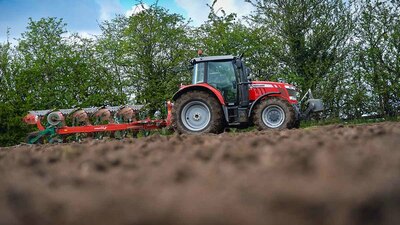
On the power harrow combination drill
Drill body
- The test: Hitched up to a three-metre Kverneland power harrow drill combination, this test combined the challenges of tight headland manoeuvres, good balance and high power demands. As with the plough, conditions varied a lot, giving the tractors plenty of opportunity to show their differences. Tyre pressures were left set at 15psi to spread the load of the drill.
- Engine characteristics: Having started with the smooth six-cylinder of the 77, then swapping to the 67, the rougher sounding four-cylinder was very noticeable. As with the two previous tasks, engine performance and fuel use was very close.
- Stability: Because of the close coupled nature of the drill, differences in balance between the two tractors was not as dramatic as with the plough, with the 67 perceived to be only slightly less stable than the 77.
- Manoeuvrability: This is where the 67 came into its own, particularly on headlands. Its shorter wheelbase meant we were soon turned around and back down another bout.
- Conclusion: Engine noise aside, for drilling we would choose the smaller 67. With traction not really an issue on this task, it is the nimble nature of the 67 which gives it the edge over the more load-lugging 77.
Drill pic
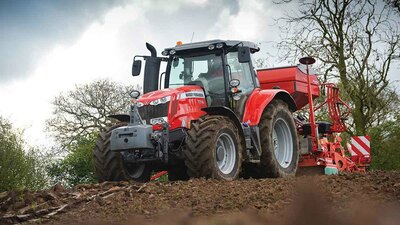
Overall verdict
When it comes to engine performance, you can hardly put a feeler gauge between the two, with both the 67 and 77 having similar characteristics and fuel use.
The differences mainly come from the physical size of the tractors, which has a noticeable effect on stability, manoeuvrability and traction.
As highlighted by our tasks, when it comes to tight manoeuvres, it is the shorter wheelbase of the 67 which gives it the edge every time. Conversely, it is the 77's longer wheelbase and extra front-end weight which offers up extra traction and surefootedness.
Therefore, when choosing between the two tractors, the size of the engine is not the issue in this case, it is more of a question as to what physical size of tractor you need for a particular job.
Verdict pic
